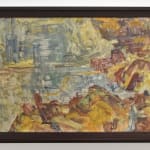



Sir Mountford Tosswill Woollaston
North of Nelson, 1960
oil on board
600 x 800mm
705 x 905mm framed
705 x 905mm framed
Further images
There is an immediacy to North of Nelson, with its brisque, energetic brushstrokes. It is a striking example of Woollaston’s depiction of landscape for which he is most celebrated. The...
There is an immediacy to North of Nelson, with its brisque, energetic brushstrokes. It is a striking example of Woollaston’s depiction of landscape for which he is most celebrated. The work’s earthy palette is the result of extended looking, of wanting to capture a likeness or essence of the landscape. Woollaston describes it as, ‘the feeling you get when you look at a distant landscape trying to penetrate it.’
Throughout his career Woollaston would often create sketches and drawings en-plein air. His son Philip describes him as sitting still in the landscape, looking - for what seemed like hours, before a flurry of action.2 For an oil such as North of Nelson, the process was more prolonged and considered, with Woollaston harnessing the passage of time, but it retains a sense of spontaneity and energy from Woollaston’s engaged practice of looking. He had an interest in the structure of painting which pushed him to play with scale, bringing elements to the forefront that felt most urgent and allowing others to recede.
By the 1960s, Woollaston was becoming well recognized as a painter. In 1958 he was awarded a Fellowship that allowed him to travel to Australia, while in 1960 he presented an autobiographical lecture, The Far-away Hills: a meditation on New Zealand landscape, to the Auckland Gallery Associates at the Auckland City Art Gallery. This lecture was later published by the Associates. Nelson and the West Coast were a primary source of inspiration throughout the artist’s career.
Woollaston was a transformative figure in Aotearoa’s art history and is widely recognised as one our pioneers of modernism. North of Nelson is a wonderful example of Woollaston’s vision of the land, at a point where his career was gaining recognition, and his painting was flourishing.
References:
1. Jill Trevelyan (ed), Toss Woollaston: A Life in Letters (Wellington: Te Papa Press, 2004)
2. https://vimeo.com/943487063
Throughout his career Woollaston would often create sketches and drawings en-plein air. His son Philip describes him as sitting still in the landscape, looking - for what seemed like hours, before a flurry of action.2 For an oil such as North of Nelson, the process was more prolonged and considered, with Woollaston harnessing the passage of time, but it retains a sense of spontaneity and energy from Woollaston’s engaged practice of looking. He had an interest in the structure of painting which pushed him to play with scale, bringing elements to the forefront that felt most urgent and allowing others to recede.
By the 1960s, Woollaston was becoming well recognized as a painter. In 1958 he was awarded a Fellowship that allowed him to travel to Australia, while in 1960 he presented an autobiographical lecture, The Far-away Hills: a meditation on New Zealand landscape, to the Auckland Gallery Associates at the Auckland City Art Gallery. This lecture was later published by the Associates. Nelson and the West Coast were a primary source of inspiration throughout the artist’s career.
Woollaston was a transformative figure in Aotearoa’s art history and is widely recognised as one our pioneers of modernism. North of Nelson is a wonderful example of Woollaston’s vision of the land, at a point where his career was gaining recognition, and his painting was flourishing.
References:
1. Jill Trevelyan (ed), Toss Woollaston: A Life in Letters (Wellington: Te Papa Press, 2004)
2. https://vimeo.com/943487063
Provenance
Private Collection, UKPrivate Collection, Auckland, NZ
Exhibitions
Group Exhibition, Spring Catalogue 2024, 25 September - 19 October 2024, Gow Langsford Gallery, Auckland, New Zealand3
of
3


